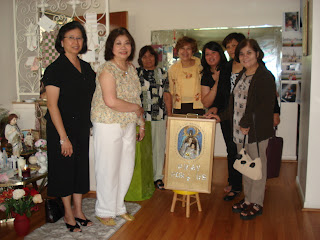Oh, my! The year 1611 is not only of religious significant to UST but also to devotees of Our Lady of Caysasay.
From: lt
Subject: FW: A Miraculous Lady In Batangas
Date: Sat, 18 Feb 2012 23:18:55 -0600
Subject: FW: A Miraculous Lady In Batangas
Date: Sat, 18 Feb 2012 23:18:55 -0600
| The miraculous Lady in Batangas, also known as Our Lady of Caysasay is not only for the Batangueños. The story of how she sprang from out of the waters way back in1603 is something for us all to cherish. Many Filipinos, while aware of local Marian sites as in Manaoag and Antipolo, are not aware of Our Lady's manifestations in Labac, Taal. Taal, after all, is more known for its small volcano. This scenic town has a lot of tourism potential and was listed in the World Heritage list since it is of the most culturally-preserved sites of the Spanish colonial era. The charming story of how the image of Our Ladyof Caysaysay was found and the numerous apparitions and miracles the Holy Image performed is best captured in the article below...
|
-->
Published 2/21/12 ust1611 multiply
Web Page: A Miraculous Lady in Batangas
+++++++++++++++++++++++++++
OUR LADY OF MANAOAG VISITING VICKI'S HOME FOR A WEEK
The Virgin Mary is the Queen of Heaven and Earth. Wherever she goes, she takes the name of the place she visits. The shrine of the miraculous Our Lady of Manaoag is in the town of Manaoag, Pangasinan. Many pilgrims visit her everyday to pray.
Our Lady of Manaoag Prayer
Virgin Mother of God, Queen of the Most Holy Rosary, those who has chosen to raise thy throne of mercy in Manaoag, to be the beloved Protectress and Patron of the Province of Pangasinan, and there from to bestow thy grace on us, thy children, banished in this valley of tears, look down with thine eyes of mercy upon me, who am beset with so many dangers of body and soul. Despite not my petition, O dearest Mother, but intercede for me before thy Divine Son now and at the hour of my death.
Virgin of Manaoag, pray for us.
 |
| Our Lady's visit is over - She's visiting another home |
Reloaded 7/27/13 ust1611 blogspot
+++++++++++++++++++++++++++++++
VISIT TO THE SHRINE OF OUR LADY OF MANAOAG
FEBRUARY 17, 2011















No comments:
Post a Comment